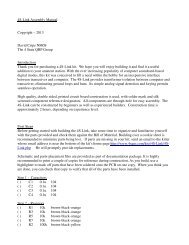G3OTH Review - Four State QRP Group
G3OTH Review - Four State QRP Group
G3OTH Review - Four State QRP Group
- No tags were found...
Create successful ePaper yourself
Turn your PDF publications into a flip-book with our unique Google optimized e-Paper software.
Russell Cook, <strong>G3OTH</strong>’s unsolicited review.Hi, I received this brand new innovative 2011 Ham Can kit from thestates in record time on Monday morning, which I put together on thesame afternoon. You can see and download full details at:http://www.wa0itp.com/hamcan.htmlI had it running on Monday night hoping that it would be as good as therecordings etc., but wondered whether I would be asking a lot from justtwo transistors.I fitted a 7030 KHz Xtal to it instead of the 7122 KHz one supplied as Ifelt the former was more suitable for us here in the UK.Using a 9 volt battery and utilising my indoor wood burning stove pipeas an antenna and my domestic central heating pipework as acounterpoise earth I copied several amateur CW stations from Europeand the USA includng Cuba late on Monday night and in the early hoursof Tuesday morning before I retired to bed.The regeneration control was not at all fiddly, regeneration is maintainedthroughout about 4 complete midway turns of the multi turn preset pot,before it plops out at each end. The selectivity is very good although thesensitivity in terms of volume is very low, as you might expect from oneAF transistor but sufficient nevertheless as all the above signals I mightadd were heard by putting my ear close to a 4 ohm loudspeaker whichwas serving as my only listening device at the time. There was a little bitof AM BC breakthrough discernable but it was not too bad. On Tuesdayduring daylight hours I heard some G stations and the breakthrough hadgone.There is NO sidetone with this circuit BTW, so you have to monitor yourCW elsewhere, but the QSK effect is really good, I listened on anotherRX and there was very little chirp although there is a small backwavepresent due to the RX regen oscillations but it is of no real consequence.I measured about 350 mW rms output into a 50 ohm dummy load whenusing 9 volts on transmit and the quiescent current on RX was about 15mA.
I have since hunted out a pair of mono phones and a hand key to see if Icould catch a fish but it has been hard work so far using Xtal control anda far from ideal antenna, although I have heard plenty of signals close tomy QRG in the process.My measured transmitting QRG seems to be about 7029 KHZ BTW withthe Xtal I am using at present.The method used to control the regen and Tx in this Ham Can has meintrigued.The four diodes seem to be arranged to provide some sort of negativebias DC feedback, the level of which depends on some combination ofclipping, pumping and voltage doubling action from the collector swingof the 2N3866, but I have not worked out yet how exactly this worksand whether it is there to benefit the RX or TX or both, I will have toinvestigate later with a scope and try and determine what is going on.I have analysed the performance of the BPF at the output of the 2N3866using Jim Tonnes W4ENE's Elsie BPF program and the values used in theHam Can are spot on for 7 MHz and provide a reasonably flat responsefrom 6 to 9 MHz.I can't see it being a problem to modify them for 80 meters, or 20meters for that matter. The PCB layout is not critical and if you are on abudget and cant afford to help the <strong>Four</strong> <strong>State</strong> Club's fine effort I am surethe whole transceiver could be copied and knocked up on perf boardquite easily for about a fiver as the regeneration is EXTREMELY stableand its control very none critical if a small multiturn preset pot is used.Hope to work some of you with it over the weekend.73 fer nw de Russ <strong>G3OTH</strong>------------------------------------Dave Cripe, NMØS’s helpful response.Russ:
Thanks for the great review of the Ham Can. I thought I'dpoint out a couple things that might not be obvious about itsoperation.1. The headphone connector is set up for stereo headphones- standard walkman earbuds work best.2. The receiver is a mix of regenerative and reflex at Q1.The diode doubler D3, D4, coupled to the collector to Q1detects the received signal, which is then sent to the base ofQ1 through the 1k resistor R1 to further boost the rx gain.3. The rx pot should be adjusted about 1 to 2 turnscounterclockwise past the point of oscillation to maximize rxsensitivity and minimize backwave.4. On TX, the large RF signal at the doubler forward biasesD2, clamping its voltage to -0.65v The signal at the base ofQ1 is clipped on the negative swing by D1, which boosts thebias current to Q1, allowing it to operate at full power.73 Dave NM0SRuss’s change to conventional stereo headphones improves audio level.Hi Dave and TerryJust found a pair of conventionally wired stereo phones that I had herewhich have individual 32 ohm earpieces and tried them with the HamCan.I now have 64 ohm effectively in series and signals sound even better !Its late here now so going off to bed.73 Russ
















